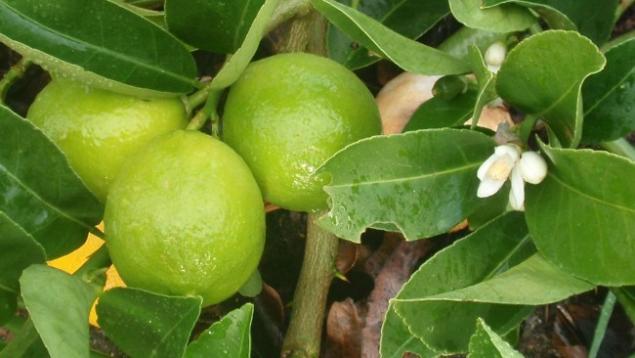430
Good for the liver lime
Lime is a small green akin to lemon citrus fruit healthy liver. The contained nutrients beneficial to many organs, including the liver. When the task is to prevent the liver disease or to suspend the already started development of the disease, freshly squeezed lime juice added to food and drinks. With the high content of vitamin C, anti-carcinogenic properties and ability to stimulate digestion, lime is an amazing fruit for anyone who wants to take care of the health of your liver and has no contraindications to the consumption of these fruits.

How useful lime and as humanity has learned about its medicinal properties? Of course, any information from the Internet about the benefits of certain products should be considered only as a subsidiary, and the methods of treatment or prevention of diseases need to consult with a doctor.
The role of lime in the history of navigation

In the 17th — 18th centuries for sailors especially dangerous were the scurvy — a disease caused by a deficiency of vitamin C. In the 18th century, British doctor James Lind (James Lind) found that lime and other vitamin C rich citrus fruits help prevent this terrible disease. Since lime always took the British ships and he played a role in the achievements of great Britain in Maritime Affairs. Moreover, even British sailors were called "Limeys".
Use lime for liver health

The ability to detoxify the liver is largely a result of the high lime content of vitamin C in one fruit about 19.5 milligrams of the vitamin. A sufficient amount of vitamin C in the diet is the standard condition of the program of detoxification of the liver. Vitamin C is a powerful antioxidant, neutralizing free radicals and thus prevent the damage that they caused to tissues and organs (including the liver). Thus, vitamin C cleanses the blood from harmful substances and prevents the harm that could be caused to the liver cells.
Lime also has anticarcinogenic properties. It contained natural compounds limonoids proved himself as a means to prevent cancer of the colon, stomach and blood. The exact mechanism of how they prevent disease, not installed, and, for this reason, liver cancer is not among the diseases preventable lime, but scientists believe that limonoids are capable of destroying cancer cells.
Contained in Lima limonoids remain active in the blood, eliminating more free radicals than green tea and dark chocolate. In patients with chronic liver disease, she can't get rid of the toxins that are harmful and can potentially cause cancer.
Lima contained in flavonoids are beneficial to digestion, stimulating the secretion of digestive (gastric) juices, acids and bile. All this improves digestion. The bile produced by the liver and used to digest fats in the bloodstream, which is an important digestive function. This prevents the accumulation of fat in the liver and the circulatory system. Bile is also a means of excretion of cholesterol.
Nutritional value of lime

In parentheses are the percentage of the daily allowance. Nutritional value is based on 100 grams of lime according to information from the Ministry of agriculture of the USA, given on the resource page Nutritiondata.self.com
General information:

Electrolytes:
P. S. And remember, only by changing their consumption — together we change the world! ©
Join us in Facebook , Vkontakte, Odnoklassniki
Source: hi-news.ru

How useful lime and as humanity has learned about its medicinal properties? Of course, any information from the Internet about the benefits of certain products should be considered only as a subsidiary, and the methods of treatment or prevention of diseases need to consult with a doctor.
The role of lime in the history of navigation

In the 17th — 18th centuries for sailors especially dangerous were the scurvy — a disease caused by a deficiency of vitamin C. In the 18th century, British doctor James Lind (James Lind) found that lime and other vitamin C rich citrus fruits help prevent this terrible disease. Since lime always took the British ships and he played a role in the achievements of great Britain in Maritime Affairs. Moreover, even British sailors were called "Limeys".
Use lime for liver health

The ability to detoxify the liver is largely a result of the high lime content of vitamin C in one fruit about 19.5 milligrams of the vitamin. A sufficient amount of vitamin C in the diet is the standard condition of the program of detoxification of the liver. Vitamin C is a powerful antioxidant, neutralizing free radicals and thus prevent the damage that they caused to tissues and organs (including the liver). Thus, vitamin C cleanses the blood from harmful substances and prevents the harm that could be caused to the liver cells.
Lime also has anticarcinogenic properties. It contained natural compounds limonoids proved himself as a means to prevent cancer of the colon, stomach and blood. The exact mechanism of how they prevent disease, not installed, and, for this reason, liver cancer is not among the diseases preventable lime, but scientists believe that limonoids are capable of destroying cancer cells.
Contained in Lima limonoids remain active in the blood, eliminating more free radicals than green tea and dark chocolate. In patients with chronic liver disease, she can't get rid of the toxins that are harmful and can potentially cause cancer.
Lima contained in flavonoids are beneficial to digestion, stimulating the secretion of digestive (gastric) juices, acids and bile. All this improves digestion. The bile produced by the liver and used to digest fats in the bloodstream, which is an important digestive function. This prevents the accumulation of fat in the liver and the circulatory system. Bile is also a means of excretion of cholesterol.
Nutritional value of lime

In parentheses are the percentage of the daily allowance. Nutritional value is based on 100 grams of lime according to information from the Ministry of agriculture of the USA, given on the resource page Nutritiondata.self.com
General information:
- energy value — 30 calories (2%);
- carbohydrates — 10.5 grams (4%);
- protein — 0.7 grams (1%);
- fat — 0.2 grams (~0%);
- fiber, part of the food — 2.8 grams (11%).
- Omega-3 19.0 milligrams
- Omega-6 is 36.0 milligrams
- folic acid (vitamin B9) — 8.0 micrograms (2%);
- Pantothenic acid is 0.2 milligrams (2%);
- choline (vitamin B4) — 5.1 milligrams;
- vitamin a, which very much is contained in dandelion — 50 international units (IU, IU) — 1%;
- vitamin C 29.1 mg (48%);
- vitamin E — 0.2 milligrams (1%);
- vitamin K, an incredibly rich source of which is sage — 0.6 micrograms (1%).

Electrolytes:
- sodium — 2.0 mg (~0%);
- potassium 102 milligrams (3%).
- calcium — 33 milligrams (3%);
- copper — 0.1 milligram (3%);
- iron — 0.6 milligrams (3%);
- magnesium — 6 mg (1%);
- manganese — 0.0 milligrams (0%);
- phosphorus — 18,0 mg (2%);
- selenium — 0.4 micrograms (1%);
- zinc — 0.1 mg (1%).
P. S. And remember, only by changing their consumption — together we change the world! ©
Join us in Facebook , Vkontakte, Odnoklassniki
Source: hi-news.ru























